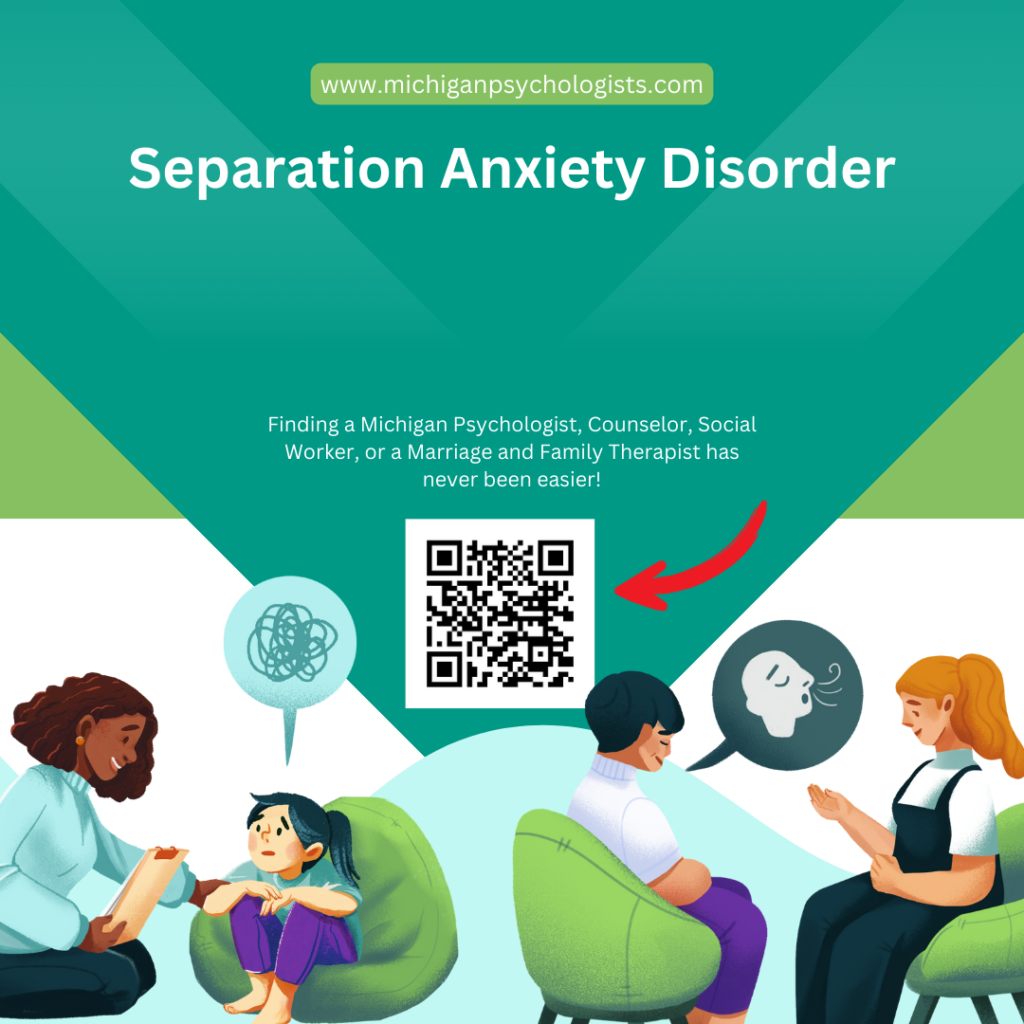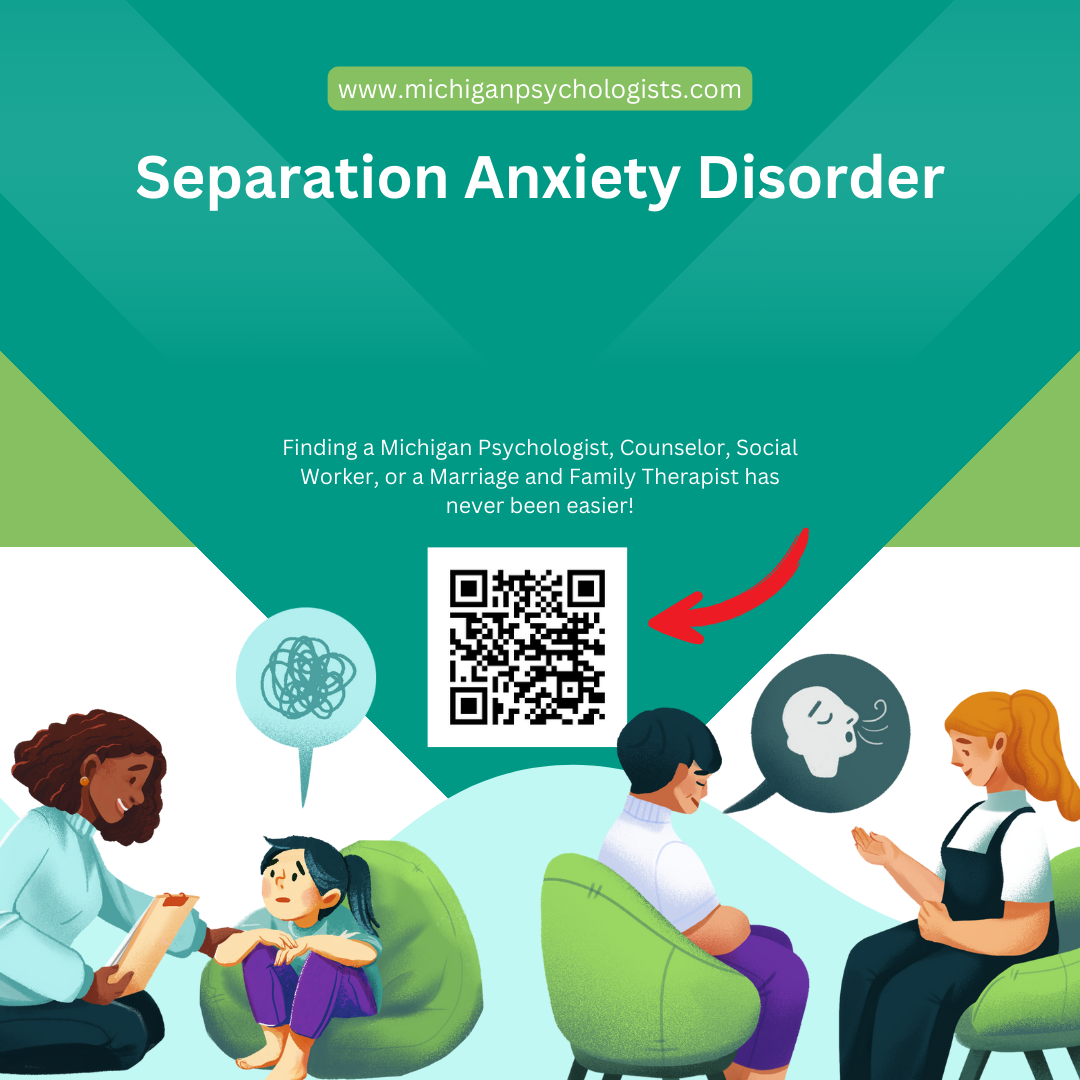Separation Anxiety Disorder
Home » Guide to DSM-5-TR Mental Health Disorders and Diagnostic Categories » Separation Anxiety Disorder

Table of Contents
Separation Anxiety Disorder Diagnostic Criteria
Presentation of Separation Anxiety Disorder
Separation Anxiety Disorder is characterized by excessive fear or anxiety concerning separation from those to whom the individual is attached. This fear is beyond what is expected for the individual’s developmental level and leads to significant distress or impairment in social, academic, occupational, or other important areas of functioning. Symptoms must persist for at least four weeks in children and adolescents and typically six months or more in adults.
Symptoms and Diagnosis
Symptoms include recurrent excessive distress when anticipating or experiencing separation from home or major attachment figures, persistent and excessive worry about losing major attachment figures or possible harm to them, persistent and excessive worry about experiencing an untoward event that causes separation from a major attachment figure, reluctance or refusal to go out due to fear of separation, fear of being alone or without major attachment figures, reluctance or refusal to sleep away from home, nightmares involving the theme of separation, and physical complaints when separation from major attachment figures occurs or is anticipated. Diagnosis involves a comprehensive evaluation by a mental health professional, including clinical interviews, developmental history, and standardized assessments.
Presentation Across Different Demographics
Children
In children, Separation Anxiety Disorder often presents with intense fear and distress when separated from parents or primary caregivers. Children may refuse to go to school or participate in activities away from home, experience nightmares about separation, and exhibit physical symptoms such as stomachaches or headaches when separation is anticipated. They may become excessively clingy and have difficulty sleeping alone. Early identification and intervention are crucial, with treatment options including cognitive-behavioral therapy (CBT), play therapy, and family counseling to help the child develop coping strategies and reduce anxiety.
Teens
Adolescents with Separation Anxiety Disorder may struggle with attending school, social events, or extracurricular activities due to their fear of being separated from attachment figures. They might express excessive worry about the safety of their loved ones and have difficulty concentrating on academic tasks. Teens may also experience physical symptoms like nausea, dizziness, or panic attacks when separation is imminent. Treatment for teens often involves CBT to address irrational fears, exposure therapy to gradually increase tolerance to separation, and family therapy to improve communication and support within the family unit.
Adults
In adults, Separation Anxiety Disorder can manifest as excessive worry about the well-being of their children, spouse, or other close family members. Adults may avoid traveling, working outside the home, or engaging in social activities to stay close to attachment figures. They might experience significant distress and impairment in daily functioning, including difficulty focusing on work or maintaining relationships. Treatment options for adults include CBT to challenge and reframe anxious thoughts, relaxation techniques to manage physical symptoms of anxiety, and medication such as selective serotonin reuptake inhibitors (SSRIs) in severe cases.
Males
Males with Separation Anxiety Disorder may present with more externalizing behaviors, such as anger or aggression, when faced with separation. They might avoid situations that require being away from their attachment figures and exhibit high levels of dependency. Males may also experience difficulty in school or work settings due to their anxiety. Treatment for males often includes CBT to address anxiety and improve coping skills, as well as behavioral interventions to manage externalizing behaviors.
Females
Females with Separation Anxiety Disorder may exhibit more internalizing symptoms, such as withdrawal, sadness, and excessive worry about separation. They might be more likely to express their fears verbally and seek constant reassurance from attachment figures. Females may also experience physical symptoms like headaches or stomachaches when anticipating separation. Treatment for females includes CBT to address anxious thoughts, relaxation techniques to manage physical symptoms, and supportive counseling to build self-esteem and independence.
Treatment Options for Separation Anxiety Disorder
Children
Treatment for children with Separation Anxiety Disorder often involves a combination of cognitive-behavioral therapy (CBT) and play therapy. CBT helps children identify and challenge their anxious thoughts, while play therapy allows them to express their fears and anxieties in a safe environment. Family counseling is also important to provide support and education to parents and caregivers on how to effectively manage their child’s anxiety and promote independence.
Teens
For adolescents, treatment strategies may include CBT and exposure therapy. CBT helps teens develop coping strategies and challenge irrational fears, while exposure therapy gradually increases their tolerance to separation. Family therapy is also beneficial to improve communication and support within the family unit. In some cases, medication may be considered to manage severe anxiety symptoms.
Adults
Adults with Separation Anxiety Disorder often benefit from CBT to challenge and reframe anxious thoughts. Relaxation techniques, such as deep breathing exercises and progressive muscle relaxation, can help manage physical symptoms of anxiety. In severe cases, medication such as selective serotonin reuptake inhibitors (SSRIs) may be prescribed. Support groups and counseling can provide additional emotional support and coping strategies.
Males
Treatment for males with Separation Anxiety Disorder often includes CBT to address anxiety and improve coping skills. Behavioral interventions can help manage externalizing behaviors such as anger or aggression. Support from family members and educators is crucial to help males develop independence and reduce their reliance on attachment figures.
Females
Females with Separation Anxiety Disorder may benefit from CBT to address anxious thoughts and build self-esteem. Relaxation techniques can help manage physical symptoms, and supportive counseling can provide emotional support. Family involvement is important to promote independence and provide reassurance.
Frequently Asked Questions (FAQ)
What is Separation Anxiety Disorder?
Separation Anxiety Disorder is characterized by excessive fear or anxiety about being separated from attachment figures, leading to significant distress or impairment.
How is Separation Anxiety Disorder diagnosed?
Diagnosis involves a comprehensive evaluation by a mental health professional, including clinical interviews, developmental history, and standardized assessments.
What are common symptoms in children?
Children may exhibit intense fear and distress when separated from parents, refusal to go to school, nightmares, and physical symptoms such as stomachaches.
How does Separation Anxiety Disorder present in teens?
Teens may struggle with attending school or social events, express excessive worry about loved ones, and experience physical symptoms like nausea and panic attacks.
What challenges do adults with this disorder face?
Adults may avoid traveling or working outside the home, experience excessive worry about loved ones, and have difficulty focusing on work or maintaining relationships.
Are males and females affected differently?
Males may present with more externalizing behaviors like anger, while females may exhibit internalizing symptoms such as withdrawal and excessive worry.
What treatments are effective for children?
Children benefit from a combination of cognitive-behavioral therapy (CBT), play therapy, and family counseling to manage anxiety and promote independence.
What support is available for teens?
Teens benefit from CBT, exposure therapy, and family therapy to address anxiety and improve communication within the family unit.
How can adults manage their symptoms?
Adults may require CBT, relaxation techniques, medication in severe cases, and support groups or counseling to manage anxiety and improve daily functioning.
What role does family play in treatment?
Family involvement is essential in providing support, education, and reassurance to help individuals with Separation Anxiety Disorder develop independence and cope with anxiety.
Separation Anxiety Disorder, as described in the DSM-5-TR, involves excessive fear or anxiety about being separated from attachment figures. This disorder can significantly impact daily functioning across different demographics, including children, teens, adults, males, and females. Understanding the presentation and appropriate treatment options for each demographic is crucial for providing effective support and improving quality of life. Comprehensive treatment plans that include cognitive-behavioral therapy (CBT), family counseling, relaxation techniques, and, in some cases, medication, can help individuals manage their anxiety and develop healthy coping strategies.
